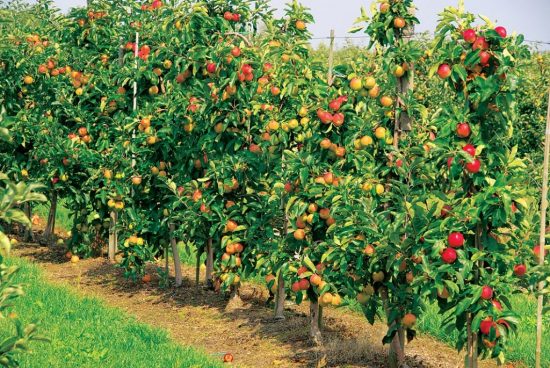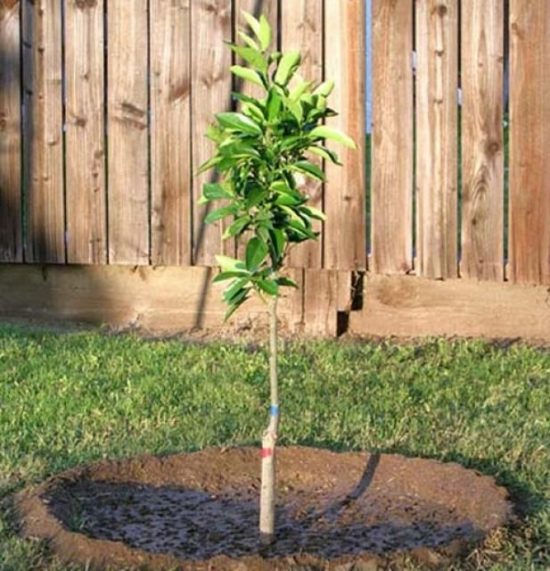Fruit trees grow in one place for decades, extracting the nutrients they need from the soil. A certain amount of these substances contained in leaves and small twigs returns to the soil after they die.
|
Only with regular fertilization do fruit trees in the garden maintain high yields and develop well. |
But the majority of the fruit is not returned, but is taken out, or, as agronomists say, is alienated along with the harvest. This naturally depletes the soil and, no matter how rich it is, it is necessary to systematically replenish its reserves in order to maintain fertility at the proper level.
Fertilizing seedlings during planting
The first feeding is done when planting seedlings. This is the so-called filling of the soil with fertilizers. The combined application of organic and mineral fertilizers gives very good results.
In every planting hole entered:
- 2-3 buckets of humus or rotted compost
- 400-600 g superphosphate
- 100-150 g of potassium salt (potassium sulfate or potassium chloride) or 1 kg of wood ash.
All these components are mixed well with the soil so that they are evenly distributed throughout the pit.
Fresh, unrotted manure should not be applied during planting; it can cause burns to the root system. It can only be used for mulching the tree trunk circle after planting.
Fertilizing young trees in the garden
|
In the future, while the trees are young and their roots do not extend beyond the crown projection zone, fertilizers are applied to the tree trunk circles. |
The norms depend on the natural fertility of the soil, the age of the garden, as well as pre-planting addition of mineral and organic fertilizers.
The average doses are as follows: per 1 sq. m of tree trunk, 3-5 kg of organic fertilizers are applied, and mineral fertilizers: urea, superphosphate, potassium sulfate - according to the instructions on the package.
Nitrogen fertilizers promote intensive growth of the above-ground tree system. They are applied in the first half of summer, since application in early autumn can delay growth and the plants will not overwinter well. The aftereffect of adding organic matter lasts 3-4 years.
Therefore, it is not necessary to apply organic fertilizers annually; it is enough to refill the soil with them once every 3 years.
Organic matter is added only in the fall when digging up the soil in tree trunk circles.
On sandy soils Fertilizing of fruit trees is carried out more often, but in small doses, especially nitrogen. Phosphorus-potassium fertilizers are planted to a depth of 18-20 cm, since they are quickly bound by the soil, move little, especially phosphorus fertilizers, and do not reach the roots of fruit plants.
How to properly feed trees in a fruit-bearing garden
In a fruit-bearing garden, the fertilizer rate is calculated for the entire territory of the garden, since by this time the trees with their roots occupy the entire area allocated for them. Approximate rates of fertilization in a fruit-bearing garden are as follows: per 1 sq. m:
- organic – 4-6 kg
- 30-40 g nitrogen
- 50-60 g phosphorus
- 50-60 g potassium
What fertilizers to apply to trees in spring
During the growing season, the need for nutrients in fruit plants changes. The spring period is characterized by intensive growth of the vegetative parts of the tree and the root system, and the growth of the leaf apparatus. At this time, all plants need increased nitrogen nutrition.
That's why first early spring feeding (on thawed soil) is carried out only with nitrogen fertilizers. It is better to use ammonium nitrate for these purposes rather than urea.
Urea must be incorporated into the soil, because When applied superficially, some of the nitrogen is lost. In the first half of the growing season, plants spend nutrients on flowering, growth of roots, shoots and fruits. During this period, increased nitrogen-phosphorus-potassium nutrition is necessary.
Summer garden feeding
The second feeding is carried out after the June shedding of the ovary with full mineral fertilizer. You can use separate application of different types of mineral fertilizers (for example, ammonium nitrate + superphosphate + potassium salt). But there are also ready-made forms of complex fertilizers: azophoska, nitrophoska, etc.
Autumn feeding of fruit trees
The third period is summer-autumn (from harvest to late autumn), during which the foundation of the future harvest is laid. At this time, fruit trees experience trunk growth in thickness, intensive growth of the root system, development of fruit and growth buds, and deposition of reserve nutrients.
That's why in the fall, enhanced phosphorus-potassium supplementation is necessary nutrition with moderate nitrogen, which promotes the formation of fruit buds and increases the frost resistance of plants.
Fertilizers for this time of application are often called “Autumn”.




 CUCUMBERS NEVER GET SICK, I'VE BEEN USING ONLY THIS FOR 40 YEARS! I SHARE A SECRET WITH YOU, CUCUMBERS ARE LIKE THE PICTURE!
CUCUMBERS NEVER GET SICK, I'VE BEEN USING ONLY THIS FOR 40 YEARS! I SHARE A SECRET WITH YOU, CUCUMBERS ARE LIKE THE PICTURE! You can dig a bucket of potatoes from each bush. Do you think these are fairy tales? Watch the video
You can dig a bucket of potatoes from each bush. Do you think these are fairy tales? Watch the video
 How our fellow gardeners work in Korea. There is a lot to learn and just fun to watch.
How our fellow gardeners work in Korea. There is a lot to learn and just fun to watch. Eye trainer. The author claims that with daily viewing, vision is restored. They don't charge money for views.
Eye trainer. The author claims that with daily viewing, vision is restored. They don't charge money for views. A 3-ingredient cake recipe in 30 minutes is better than Napoleon. Simple and very tasty.
A 3-ingredient cake recipe in 30 minutes is better than Napoleon. Simple and very tasty. Therapeutic exercises for cervical osteochondrosis. A complete set of exercises.
Therapeutic exercises for cervical osteochondrosis. A complete set of exercises. Which indoor plants match your zodiac sign?
Which indoor plants match your zodiac sign? What about them? Excursion to German dachas.
What about them? Excursion to German dachas.